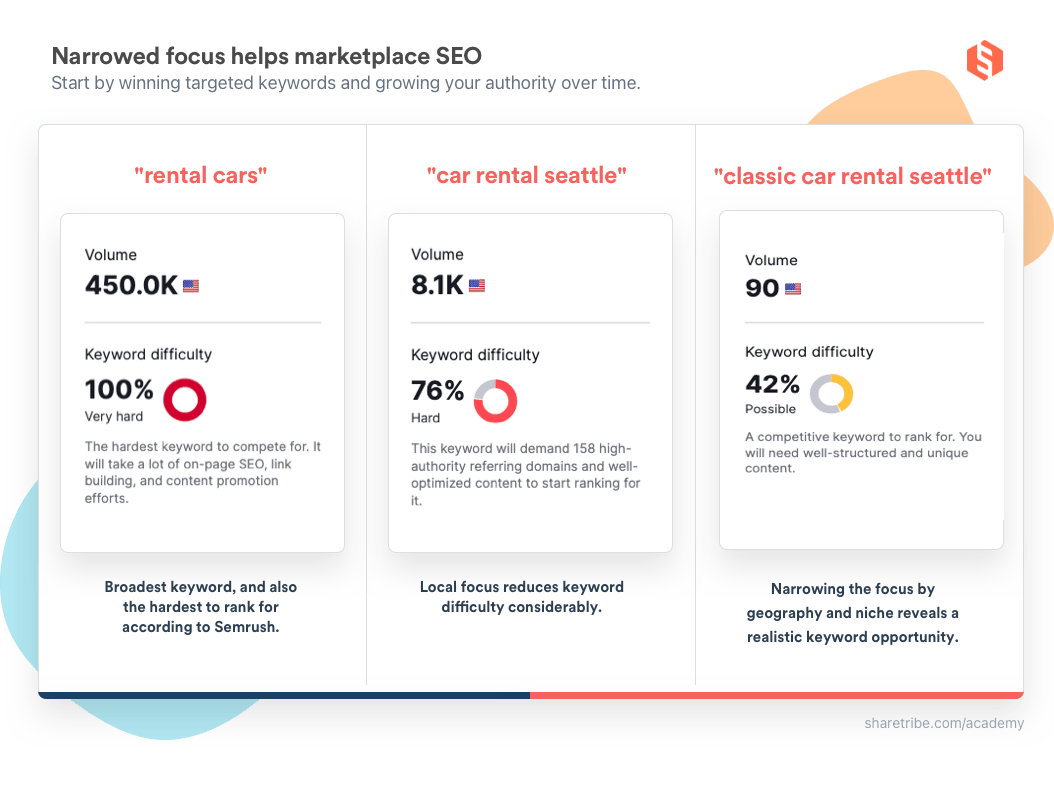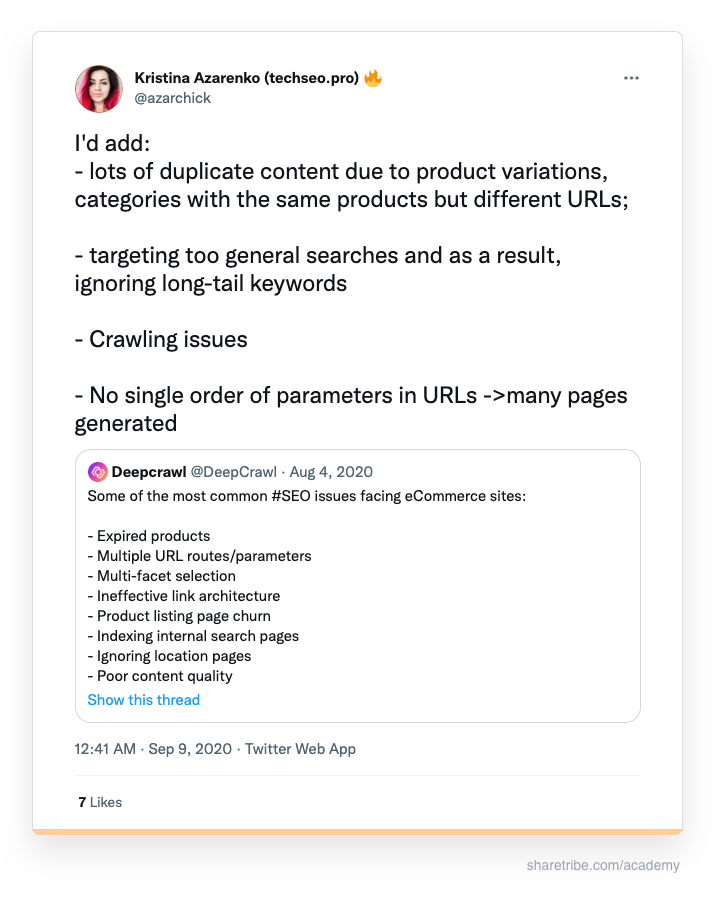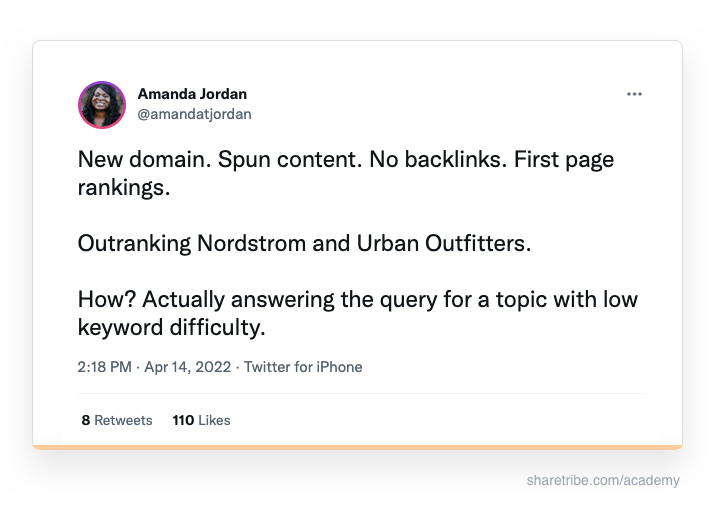Opportunities and challenges of marketplace SEO
How to avoid common marketplace SEO pitfalls – and tap into the unique opportunities.
Published on
Last updated on

When it comes to SEO, marketplaces have unique opportunities and challenges. Solving these challenges requires understanding some technical aspects of SEO – and lots of work. But the opportunities can make the investment more than worthwhile.
“Marketplaces are such gigantic websites that the return on investment from SEO can really drastically improve the bottom line. And also improve the actual valuation of the company.”
Mike van der Heijden is the founder and Managing Partner of Portal Ventures, an agency that helps marketplaces improve their SEO. When I asked him why their focus is particularly on marketplaces, Mike said its because SEO can be an especially impactful marketplace growth strategy.
SEO is also more challenging for marketplaces than many other websites. That's because they’re very different from traditional business websites and blogs. Gregory Edwards, SEO Manger At BlueArray, has specialized in working with online marketplaces and says there are many SEO challenges he consistently encounters on marketplaces.
Michael Caldwell, co-founder of the marketplaces GigMasters (now The Bash) and Petworks, would go as far as to say marketplace SEO is a field of expertise in its own right.
“With GigMasters, we would hire local SEO companies or experts, and they would quickly become overwhelmed with the scope of what we were trying to optimize. They had done work for one restaurant or one doctor’s office. That’s a totally different ballgame from a marketplace.”
To form a solid foundation for your SEO strategy, you need to understand both the opportunities marketplaces have and the challenges you’re up against. In this article of the complete guide to marketplace SEO, my goal is to help you steer clear of the common pitfalls and find the biggest wins.
All sites face challenges with site structure and technical SEO. But the fundamental two-sided nature and the specific structure of marketplace websites can make SEO issues likelier and more difficult to overcome.
In general, many of the common SEO issues that affect eCommerce websites are highlighted on marketplaces.
On a marketplace, the website's size and structure can easily get out of control.
Mike van der Heijden and Gregory Edwards both say this is quite natural for marketplaces and a result of business growth. More providers find the platform, and it may expand to entirely new niches and locations. At the same time, some parts of the site’s inventory run out, or certain categories or locations dry up.
As a result, the number of URLs on the marketplace increases. However, a significant part of the pages doesn’t have any relevant content. According to Google, having many URLs that add low to no value can negatively affect a site's crawling and indexing.
Michael Caldwell experienced this firsthand when building GigMasters.
“The scope of what you’re optimizing for SEO is huge with marketplaces,” Michael says.
“We started GigMasters with a certain number of categories: bands, DJs, string quartets. But as time went on, we realized we needed more specific categories: reggae bands, mariachi bands, acoustic guitarists. Before you know it, you have 40–50 categories. And then multiplied by location: reggae bands in Boston, DJs in Houston.”
Another common reason for a bloated site structure is the marketplace category structure.
“A lot of marketplace owners build a big website and try and go, ‘Hey, we've got all this supply across all these categories´,” Mike says.
“But as a result, they spread themselves really thin. Their marketplace could have a thousand or a hundred thousand different pages, but all that's available on each page is one piece of inventory.”
It’s a good idea to plan how you arrange your marketplace categories when you’re building the very first version of your platform. A well-structured website is a solid UX investment even if it turns out that SEO is not a valid growth strategy for you.
I’ll talk about marketplace site structure in more detail in the next article of the series.
“Consistent site quality always tends to be an issue on large-scale marketplaces”, Gregory Edwards says.
This is a natural consequence of site structure issues on a marketplace. When the number of pages on your marketplace increases, chances are you’re no longer in full control of the content on all those pages.
This causes two main site quality issues: thin content and duplicate content.
Thin content (sometimes also called low content) means pages that lack rich, informative text and images. According to Google, one of the most important ways to improve your site’s rankings is to ensure it contains plenty of rich information.
Users on large marketplaces can also contribute to thin content issues. Users may post incomplete listings or profile pages, which, on a large scale, can have a negative impact on your rankings.
Duplicate content means that two or more URLs have identical or near-identical content. Search engines might then not know which page you want them to rank. The issue gets highlighted if you build links to multiple versions of essentially the same content. As a result, these pages risk being ranked lower than they would without the evil twin.

There are many reasons why content might be duplicated, most of them technical. On marketplaces (and other eCommerce sites), duplicate content often happens due to search filter results pages and pagination. Providers might also create duplicate and thin content by posting low-quality listings.
There are a number of technical things you can do to fix thin and duplicate content, and I’ll discuss those in detail in the next article. You should also educate your providers on the importance of high-quality, unique listing and profile content.
You’ve probably read it in this blog several times already: building a marketplace is like building two different businesses. One for the provider side and one for the customers. So, it’s quite understandable that these two sides would behave very differently in Google as well.
Michael Caldwell’s advice is to use SEO to grow your demand side after you’ve built the initial supply. According to a study by Lenny Rachitsky, most of today’s best-performing marketplaces have found SEO to be more impactful for growing the demand side than the supply side.
This makes sense. The customer side is likely to google a solution to a specific problem like “I want to find a dog walker in my area”. Providers, on the other hand, might not know about the opportunity to offer dog walking online at all. They would probably not be googling something like “how to offer dog-walking services online”.
The fact that SEO generally isn’t a tool for supply-building doesn’t diminish its value in growing demand. But it does mean you need to be strategic about your marketplace marketing mix.
You need to balance liquidity carefully as you grow your audience. If you’ve onboarded a hundred high-quality providers, they might lose interest if your customer acquisition is pending on SEO to kick in. But if your supply-side lags behind, the crowd of customers your SEO efforts bring won’t find anything to buy.
What helps is a solid SEO strategy that sets realistic expectations on the volume and schedule of growth – and is balanced by other growth tactics.
Online marketplaces don't have a lot of "blue ocean" left. The marketplace model has spread rapidly, especially in B2C and C2C. Whatever you’re buying or renting, there’s probably a marketplace for it.
It’s also more and more likely that your biggest marketplace competitor is also doing SEO. When Lenny Rachitsky interviewed marketers from today’s biggest marketplaces, 40% of them mentioned SEO as a key driver of early demand-side growth.
If the incumbent has invested heavily in SEO for a long time, outranking them, as Mike van der Heijden says, takes very deep pockets.
But your strategies aren’t limited to outranking industry leaders in their top keywords. You can go all-in on the marketplace verticalization trend. Limit your geography and narrow down your category.
“Marketplaces are getting more and more niche. And because of that, they’re able to dominate and be an expert on a particular topic,” Mike says.
Have a look at the three keywords below.
The first one, “rental cars,” is very high in volume and has the highest possible difficulty level. The difficulty score is an estimate of how much competition there is for the keyword. (The information on volume and difficulty is derived using Semrush).
The other two keywords are variations of "rental cars", but with a narrower focus. Limiting the approach to a specific location (Seattle) and/or category (classic cars), you get to a much more accessible keyword in terms of difficulty.

Sure, the volume is also lower. But for an early-stage marketplace, that's probably a trade-off worth making for a realistic keyword opportunity and a very targeted audience.
And as you gain users in your first niche and your marketplace builds authority, you can start to take on more difficult keywords.
User-generated content can pose all kinds of challenges to a marketplace admin. It’s a lot of work to control listing quality, keep image sizes in check, and make sure nothing inappropriate gets published. And, as you learned above, users may inadvertently contribute to creating thin or duplicate content.
Nevertheless, Michael Caldwell sees user-generated listing content as an asset for marketplaces.
“Listings are a great opportunity for SEO! For example, the content on Petworks listings is rich, original content provided for us by pet care professionals,” he says.
“And forget SEO for a second. Creating a richer listing is going to help providers get hired because it’s more compelling.”
Rich listing content rarely happens by accident. On the contrary: without encouragement, many providers might speed through the listing creation process.
The Petworks team regularly runs reports to find listings that, for example, have less than 150 characters in the description. They then reach out to the providers with advice on creating compelling, keyword-rich descriptions and headings. Sometimes, the providers even let the team edit the listings on their behalf.
“They think it’s great; they feel they’re getting a concierge-level service. And it’s a win for us because it lets us improve the overall strength of not just their listing but our domain as a whole.”
Michael’s team also found an ingenious way to boost the SEO power of Petworks’ listings while reducing the amount of work required for manual content moderation. They built a simple listing strength meter that gives providers real-time feedback on their listings. The meter starts out red, but as a provider types in more text, the meter color turns yellow and then green.
“When we ran our average content length reports after publishing the listing strength meter, we noticed that listing length had started to grow.”

Marketplaces have a great opportunity to build a marketplace community around them. This community can also boost your SEO efforts.
If your providers are businesses or individuals with an existing customer base, websites, or social media visibility, you can encourage them to share their profile and listing pages through their networks. This builds your visibility and strengthens your domain authority through relevant, high-quality links.
Your marketplace community also presents you with content opportunities.
Look into the questions and problems your demand side has and leverage your providers’ expertise to produce quality content. Interview your best providers and use the material to highlight their success and educate other providers. Pitch story ideas featuring your most successful, unusual, or otherwise interesting providers for local or niche media.
When you work with your community and they feel involved, they're also more likely to amplify your content through their channels. As a bonus, it strengthens the sense of belonging within your marketplace community.
SEO generally works best for growing demand. But it can bring an unexpected boost to the supply side as well.
First of all, you may find some keyword opportunities for the supply side as well if your market is well-established. For example, “Sell tickets online” has a good 12K monthly search volume globally, so Eventbrite has a landing page for this query.
Even more importantly, Michael Caldwell says demand generation can boost supply acquisition in many indirect ways.
“Sometimes, pet professionals are doing their own keyword research when they see our marketplace on the first page of Google. They say to themselves, ‘OK, I can leverage their SEO strength by becoming a part of their marketplace.’”
This is a great value proposition for providers evaluating if the platform is worth joining.
“As experts, our providers are devoted to animals and animal care. They don’t necessarily want to spend their time studying Core Web Vitals in Google Search Console,” Michael says.
“While you focus on SEO for the demand side, the supply side is watching.”
As you grow your SEO strength, Michael points out that you might even be able to use it as a value proposition that makes your platform worth paying for also for the supply side.
Eventually, your success in SEO can bring a whole new level to your supply-side value proposition, as this fascinating example from Eventbrite shows.
Eventbrite is one of the best examples of leveraging SEO for marketplace growth. I highly recommend listening to this discussion between our CMO Sjoerd Handgraaf and Eventbrite’s marketplace legend Casey Winters for insights on how SEO has shaped Eventbrite’s strategy.
Talking to Michael Caldwell, Mike van der Heijden, and Gregory Edwards, one thing became very clear: marketplace SEO is its own category of SEO that requires specific expertise.
Marketplaces are challenging websites to build. Adding SEO considerations to the mix can increase the challenge. The marketplace website structure requires careful consideration or it can get out of hand, which might also create duplicate and thin content issues. Furthermore, the majority of content on marketplaces is user generated, which means maintaining high quality can be challenging.
And, as with all marketing strategies for marketplaces, you need to remember to balance your demand-side and supply-side acquisition to maintain liquidity.
But marketplaces also have unique SEO opportunities. Your user community is an advantage that can bring your SEO a boost that other website owners can only dream of. If you manage to tap into your community, it can have a far-reaching impact on the value your business creates.
The following articles go deeper into the practical side of solving marketplace-specific SEO challenges and leveraging the opportunities. The first stage is making sure you’re building your website in a way that takes technical SEO best practices into account.
You might also like...

Marketplace SEO: the complete guide
Get a comprehensive introduction to the world of SEO, tailored specifically to online marketplaces.

Focus your marketplace on one city and one vertical
Tackle the chicken-or-egg problem with an extreme focus.

Brian Rothenberg at the Marketplace Conference: Driving growth via buyer/seller overlap
Trust Eventbrite’s VP of Growth: if customers are turning to providers on your marketplace, you’re on to something magical.
Start your 14-day free trial
Create a marketplace today!
- Launch quickly, without coding
- Extend infinitely
- Scale to any size
No credit card required


